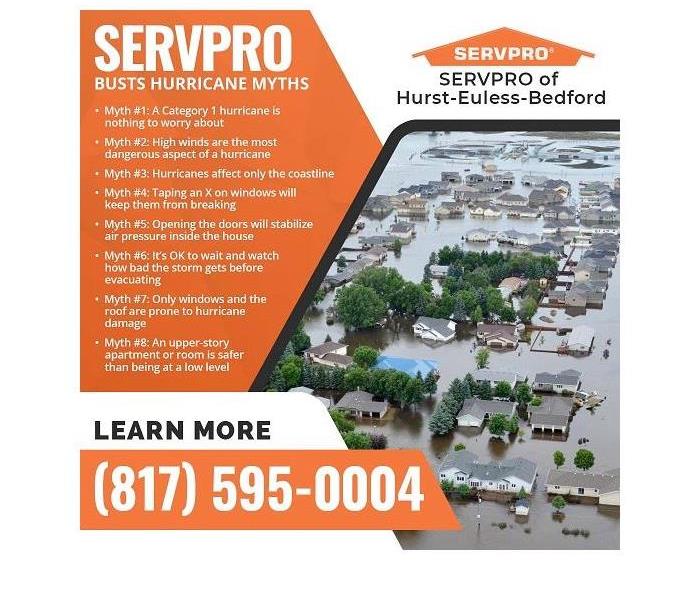SERVPRO: Hurricane myths busted
9/23/2021 (Permalink)
Blog summary: The SERVPRO blog discusses the myths that surround hurricanes and shares the truth.
SERVPRO busts hurricane myths
Hurricanes are a force of nature that wreak havoc in their wake. While this phenomenon is not in anyone’s control, preparing for it is possible. There are, however, many myths around hurricanes that lead to poor decision-making by citizens and jeopardizes their lives. SERVPRO busts these common myths surrounding hurricanes.
Myth #1: A Category 1 hurricane is nothing to worry about
A category 1 hurricane as per the Saffir-Simpson Hurricane Wind scale comes with sustained wind speeds of 74 to 95 miles per hour. The scale has five levels with Category 5 hurricanes that pack sustained winds of 157+ miles per hour that can destroy everything in its path and make the area inhabitable.
Even though a higher category storm causes greater devastation, a Category 1 storm can damage the roofs and siding of solidly built homes, damage trees, and cause power outages for days. Therefore, it must not be taken lightly.
Myth #2: High winds are the most dangerous aspect of a hurricane
Wind speeds of up to 157+ miles per hour wreak havoc on life and property but the maximum damage is caused by flooding due to heavy rainfall and storm surges. Storm surge occurs when strong winds push the water into shore, leading to flooding. Nearly half of the fatalities in the US are caused by storm surges whereas heavy rainfall accounts for 25 percent of the fatalities.
Myth #3: Hurricanes affect only the coastline
The maximum damage is located along the coast but people living inland need to be prepared for extensive rainfalls, high winds, storm surges, and possible tornadoes that follow. Storm-surge flooding can reach inland well beyond 10 miles, and heavy hurricane rainfall often leads to inland river flooding far from the shoreline. Moreover, all tropical storm and hurricane warnings are issued based on their potential impact on the inland areas.
Myth #4: Taping an X on windows will keep them from breaking
Taping a big X over the windows will not prevent the debris from crashing through the windows and inside the house. Installing storm shutters over windows and glass doors or nailing temporary plywood boards over the glass is what helps.
Myth #5: Opening the doors will stabilize air pressure inside the house
Another existing myth is that opening doors or windows during a hurricane or tornado will stabilize the air pressure between the house’s interior and exterior. This will, in fact, not make any difference in the pressure dynamics but will expose the house to flying debris and flooding.
Myth #6: It’s OK to wait and watch how bad the storm gets before evacuating
Once an evacuation is announced, many people choose to remain at home trying to protect their belongings or in the hope that the storm will not be so bad. This not only puts the life of the inhabitants at risk but also jeopardizes the lives of responders. It is important to follow the weather reports on the storm, prepare for its arrival, and be ready to leave when the government announces emergency evacuation.
Myth #7: Only windows and the roof are prone to hurricane damage
Window and the roof are often damaged by the hurricane but another area that causes major damage is garage doors. Since garage doors are large yet jointed, high winds can destabilize them and pull them off their tracks or collapse. Thereafter, winds can enter a home through the garage door and cause serious damage. Getting a garage door that is hurricane-proof or reinforcing the door with a garage door retrofit kit can help take care of this vulnerability.
Myth #8: An upper-story apartment or room is safer than being at a low level
The Federal Emergency Management Agency recommends taking shelter on a lower level as the wind speed is more intense at higher levels and increases the risk of broken windows and flying debris. Higher up means more danger.
In case of storm damage to a property, homeowners must contact professional storm damage restoration teams such as SERVPRO to help restore their homes swiftly and efficiently.
Why SERVPRO?
- SERVPRO uses state-of-the-art equipment to bring the damaged property back to its original state. SERVPRO of Hurst-Euless-Bedford is always updating its fleet and equipment so clients in Hurst, Euless, Bedford, or anywhere else can quickly access the services.
- With over 1,700 US and Canadian Franchise locations, SERVPRO is strategically positioned to respond faster to an emergency of any magnitude.
- The SERVPRO staff is highly trained in property damage restoration. They receive initial in-house training and constant skill-up-gradation at the corporate training facility and also acquire the regular IICRC-industry certification.
For storm damage restoration services, call SERVPRO of Hurst-Euless-Bedford today at (817) 595-0004 or e-mail at office@SERVPROheb.com





 24/7 Emergency Service
24/7 Emergency Service
